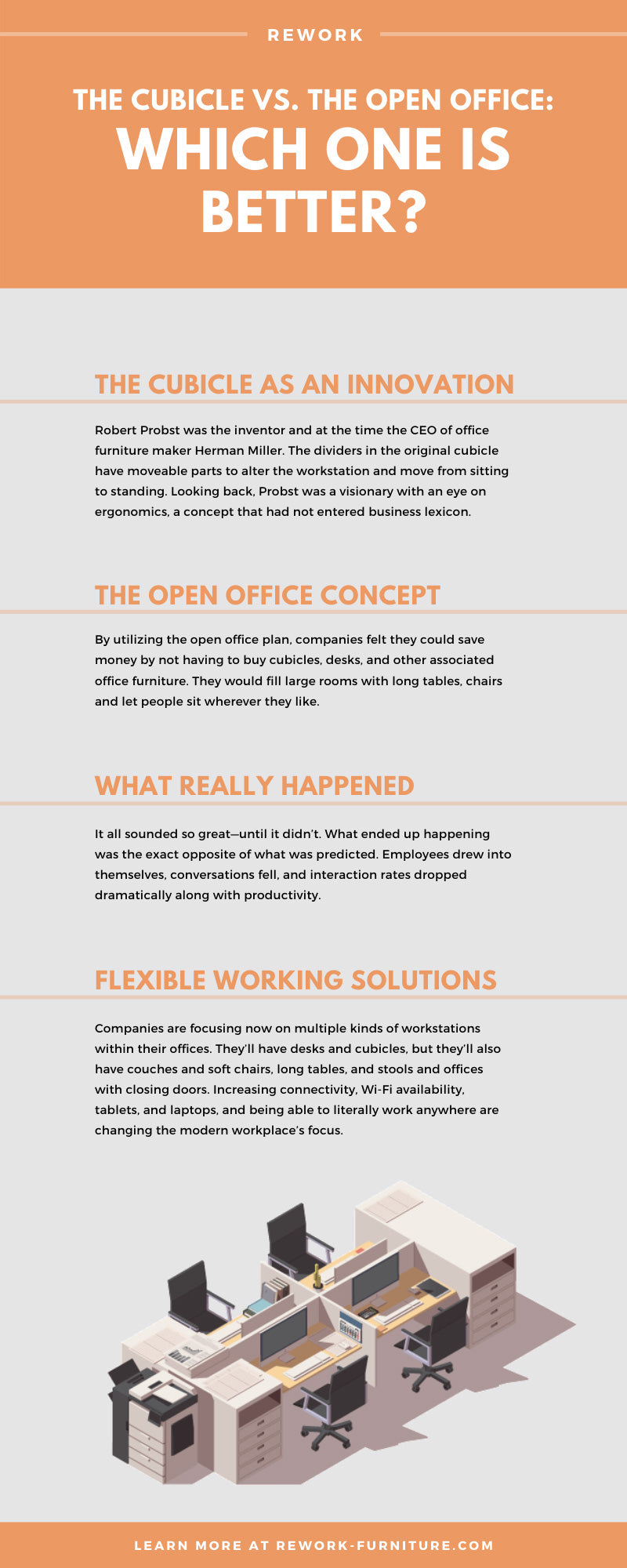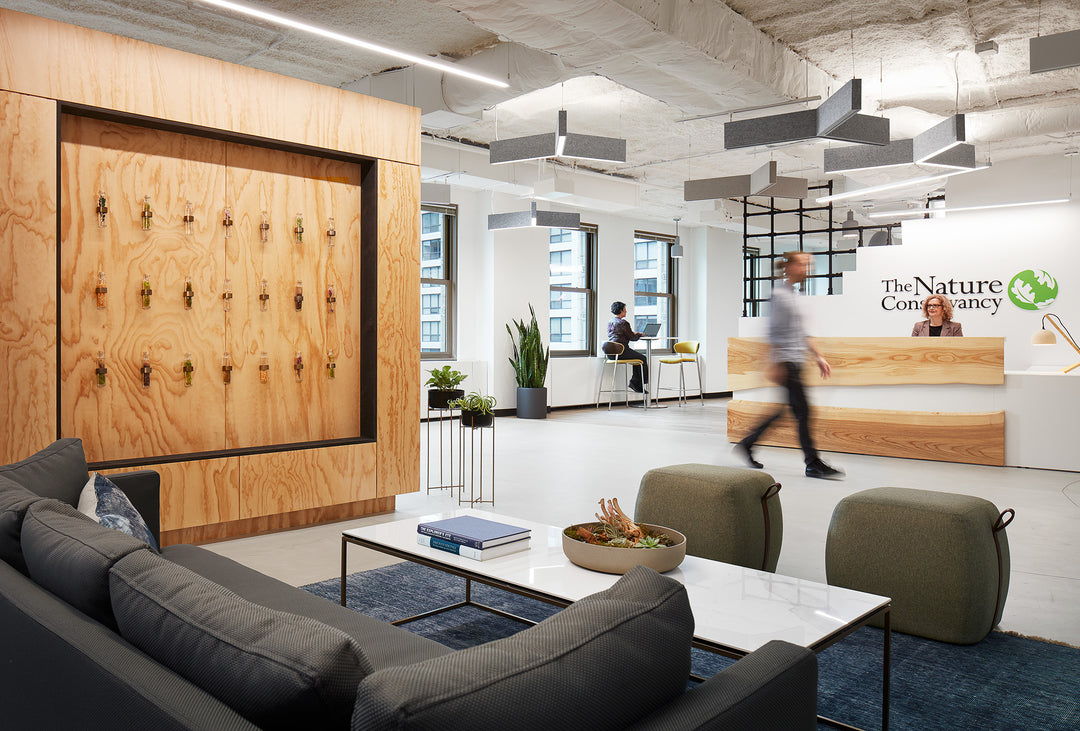The Cubicle vs. The Open Office: Which One Is Better?
In the mid-1990s, famed advertising executive Jay Chiat hatched a bold new plan for his team and office. He was going to radically redesign the office in a way that was never seen before. He wanted to promote brainstorming and collaboration among his creative teams, and to do that, he felt the best way was to break down barriers—literally. Chiat is the pioneer of the open office design, or as he called it, the virtual office. His vision was to get rid of all private offices, cubicles, and walls to open up the office and get people talking. There would be no more personal desks, only open spaces with tables and chairs. Employees would have lockers to keep their personal effects in and laptops for day use only. Using technology, his people would boost creativity by moving freely and fluidly in the first open office.
Within six months the employees rebelled, and within a year and a half, the concept was a total disaster. The open office plan and the more traditional office space are diametrically opposing concepts. The discussion about the cubicle vs. open office spaces began. So, which one is better, the cubicle or the open office?
The Cubicle as an Innovation
When the cubicle was invented in the 1960s, it was a revolutionary way to chop up the office space and give people a place to work. Robert Probst was the inventor and at the time the CEO of office furniture maker Herman Miller. He called his groundbreaking invention the “action office”. His concept was simple; workers had some privacy to do their work and flexibility to do it. Flexibility and cubicles don’t go together all that well, but Probst’s original design made it possible. The dividers in the original cubicle have moveable parts to alter the workstation and move from sitting to standing. Looking back, Probst was a visionary with an eye on ergonomics, a concept that had not entered business lexicon.
Other furniture makers caught on to the new invention and started making their own versions of the action office; however, what was once an invention full of promise morphed into the space of nightmares that is panned universally on TV and in movies. As private office cubicles became the norm in offices around the world, workers began to view them in a not so favorable light, and the idea of sitting in one all day doing clerical work was soul-crushing. The demise of the cubicle came around 1999 with the release of the movie “Office Space” and the depiction of white-collar office workers as miserable people confined to tiny office spaces.
The Open Office Concept
The open office seating concept was created by business leaders. Business leaders started to pay attention to employee morale and the depiction of the cubicle and realize the two were tied together. Their response was to go the opposite direction and remove all the cubicles and designated spaces to embrace the open office plan. By utilizing the open office plan, companies felt they could save money by not having to buy cubicles, desks, and other associated office furniture. They would fill large rooms with long tables, chairs and let people sit wherever they like. The added benefit was that this new open design would promote openness among coworkers. In this new, free, and open space ideas would be able to flow freely, and people would talk and brainstorm together more.
Shedding the shackles of the old ways of drab walls and mini prison cells, young startup companies were championing the open office concept, painting the walls bright colors and letting the world know they were a new and vibrant company. The turn of the twenty-first century saw many changes to the business world, most notably how modern offices were designed with an eye on brainstorming and collaboration. Now employees were the most important commodity, and their comfort and productivity came to the forefront.
What Really Happened
This golden age of collaboration was supposed to make it easier for workers to get together. Open, flexible, activity-based spaces were replacing cubicles all over the world, bringing people into the open. Productivity will skyrocket as employees talk about projects and work in an unfettered environment with the free exchange of ideas. It all sounded so great—until it didn’t. What ended up happening was the exact opposite of what was predicted.
Employees drew into themselves, conversations fell, and interaction rates dropped dramatically along with productivity. So, what happened? French philosopher Denis Diderot wrote that actors in a play should imagine a huge wall across the front of the stage, separating them from the audience, and behave exactly as if the curtain had never risen. He called this the “fourth wall”. It prevents actors from being distracted by the audience and removes them from that which they can’t control. It is the same as a basketball player standing at the free-throw line, ignoring the taunts and screams of the fans right in front of him. The larger the audience, the more important the fourth wall. Workers in an office create a fourth wall and their peers respect it. If someone is working intently on a project, no one will interrupt them. If someone tries to start a conversation and is given a dirty look, they won’t do it again. In open offices, fourth wall norms spread quickly.
Flexible Working Solutions
Somewhere in the middle lies the answer to these extremes. Like all things, there is no “one size fits all” solution to the office design. What works for company A will not work for company B. The response to the failure of the open office concept is to create flexible workspaces that go beyond a brick-and-mortar solution. Companies are focusing now on multiple kinds of workstations within their offices. They’ll have desks and cubicles, but they’ll also have couches and soft chairs, long tables, and stools and offices with closing doors. When comparing open office space offices bs cubicles, it is important to remember that not every person works the same way and applying a blanket office design will only continue to hinder the communication and productivity all companies seek. Giving employees the flexibility in their jobs to work where and how they want is the next concept. Increasing connectivity, Wi-Fi availability, tablets, and laptops, and being able to literally work anywhere are changing the modern workplace’s focus. Now, working where you want, as long as the job gets done, is replacing sitting in the office for 8 to 10 hours a day. Time will tell if this is any more effective than previous workplace iterations.
Revive your office environment with Rework office furniture in Chicago. We provide full-service furniture solutions using smart design, eco-friendly practices, and professional installation.

Which One is Better?




